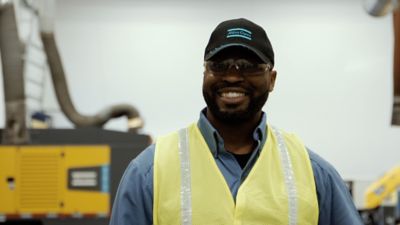Oxygen Generators
OGV+ VPSA oxygen generators
OGV+ VPSA oxygen generators for oxygen demand above 100 kg/h

- Description
- Industries
- Benefits
- VSA, VPSA and PSA
- Specification
- Downloads
- Related products
- Services Contact us
Description
OGV+ VPSA industrial oxygen generator
The OGV+ VSA industrial oxygen generator is 100% oil-free technology with an integrated drying layer and large turndown ratio with variable flow blower and extractor, ensuring maximum energy savings.

How does an OGV+ VPSA industrial oxygen generator work?
Atlas Copco OGV+ VPSA oxygen generators consists of two adsorption columns in parallel, in batch sequence switched by automatically controlled valves. Each column includes a drying layer that removes moisture plus CO2 followed by a zeolite type adsorption layer that separates the nitrogen from the air so that the desired component oxygen remains.
In this VPSA process, air is sent via a blower into one adsorption column separating the oxygen present in the air from the nitrogen. Once the zeolite in this column is saturated with captured nitrogen, the adsorption cycle automatically switches to the other tower starting adsorption from a freshly regenerated bed ensuring an uninterrupted stable supply of oxygen gas.
Simultaneously the first ‘saturated’ tower will be regenerated by an extractor pump that extracts the moisture and nitrogen from the adsorption material making it ready for re-use again.
Industries
Benefits
Benefits






VSA, VPSA and PSA
What is the difference between VSA,VPSA and PSA
Oxygen VSA (Vacuum Swing Adsorption), Oxygen VPSA (Vacuum Pressure Swing Adsorption) and Oxygen PSA (Pressure Swing Adsorption) are processes used to separate oxygen from other gases in the air. These processes typically consists of two adsorption columns in parallel, in batch sequence switched by automatically controlled valves. Each column includes a zeolite-type adsorption layer that separates the nitrogen from the air so that the desired component oxygen remains.
VSA and VPSA technology use a blower to feed air to the oxygen generator to produce oxygen. However, here lies the main difference between VSA and VPSA. In VSA the typical delivery pressure of the blower is a maximum 200-300 mBar (3-4 psi). For VPSA, the typical delivery pressure of the blower lies between 300-1000 mBar (4-15 psi). The consequence is that the VPSA technology can delivery higher oxygen pressure.
To be able to remove the captured nitrogen molecules, both VSA and VPSA technologies use a vacuum pump to remove the captured nitrogen in a process step we call regeneration. In both technologies, vacuum pressure levels are the same.
Therefore, the main difference between Oxygen VSA and Oxygen VPSA is that VSA operates at lower blower pressure and VPSA operates at higher blower pressure. Also, VSA is typically used for lower purity applications, while VPSA can produce higher purity oxygen.
Then what is PSA? PSA is similar to VPSA but simplified without a vacuum pump. Instead of using a blower, a compressor is used to deliver feed air of around 7 Bar (100 psi) to the zeolite bed. Once the zeolite bed in PSA is saturated with captured nitrogen, the pressure is reduced to atmospheric pressure where the nitrogen automatically desorbs, without the help of a vacuum pump, leaving behind pure oxygen. Due to the use of a compressor instead of a blower, typical oxygen delivery pressure is 3.5 Bar (50 psi).
Specification
Technical specification
| Model | Flow at 93% oxygen level | Dimensions CM-In | Weight | ||||||
| Nm3/h | scfm | kg/h | tons/day | W | D | H | kg | lbs | |
| OGV80+ | 80 | 47 | 105 | 2.5 | 2477-975 | 2989-1177 | 3609-1421 | 4086 | 9008 |
| OGV105+ | 105 | 62 | 138 | 3.3 | 2523-993 | 3042-1198 | 3609-1421 | 4710 | 10383 |
| OGV160+ | 160 | 94 | 210 | 5 | 2714-1068 | 3233-1273 | 3770-1484 | 6432 | 14290 |
| OGV270+ | 270 | 159 | 355 | 8.5 | 3578-1409 | 3899-1535 | 4037-1589 | 10140 | 22354 |
| OGV400+ | 400 | 235 | 525 | 12.6 | 3891-1532 | 4260-1677 | 4227-1664 | 14090 | 31063 |




